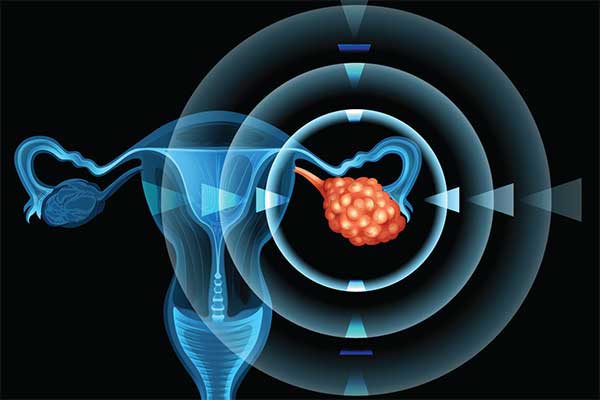— Benefits platinum-sensitive disease irrespective of BRCA, homologous repair status, study showed
Patients with relapsed platinum-sensitive ovarian cancer had significant improvement in progression-free survival (PFS) when retreated with the PARP inhibitor olaparib (Lynparza), a randomized trial showed.
Patients with BRCA-mutant ovarian cancer had a median PFS of 4.3 months with olaparib versus 2.8 months with placebo, whereas the BRCA wild-type subgroup had median values of 5.3 and 2.8 months. Olaparib maintenance conferred a similar benefit for tumors exhibiting homologous recombination deficiency (HRD) and those without.
The safety and tolerability of olaparib were consistent with the profile observed during initial treatment with the PARP inhibitor, reported Eric Pujade-Lauraine, MD, PhD, of the ARCAGY-GINECO cooperative group in Paris, during the virtual meeting of the European Society for Medical Oncology (ESMO).
“In a heavily pretreated ovarian cancer population, rechallenge with maintenance olaparib following response to platinum-based chemotherapy provided a statistically significant improvement in progression-free survival compared with placebo, regardless of BRCA mutation status,” said Pujade-Lauraine. “In both BRCA-mutated and non-BRCA cohorts, a proportion of patients derived clinically relevant long-term benefit from maintenance olaparib rechallenge. In the non-BRCA cohort, patients appeared to benefit regardless of HRD status.”
The results addressed an unresolved issue related to PARP inhibitor maintenance therapy in ovarian cancer. PARP-inhibitor maintenance is standard of care for newly diagnosed ovarian cancer and for patients with relapsed platinum-sensitive disease and no prior exposure to a PARP inhibitor. In the relapse setting, patients with and without BRCA mutations benefit from PARP inhibitor maintenance.
Although most patients achieve durable responses, a majority eventually relapse, Pujade-Lauraine continued. Whether patients with prior PARP inhibitor maintenance therapy will benefit from PARP-inhibitor rechallenge response to platinum chemotherapy remained unclear. Investigators in the multicenter randomized OReO/ENGOT Ov-38 trial sought to answer the question.
The study included a total of 220 patients with relapsed, platinum-sensitive ovarian cancer, prior maintenance therapy with olaparib, and response to the most recent line of platinum-containing chemotherapy. The study population comprised 112 patients with BRCA-mutated disease and 108 without BRCA mutations.
Eligibility criteria for the BRCA-mutated cohort included at least 18 months of PARP-inhibitor maintenance in first line or at least 12 months in later lines of therapy. In the non-BRCA group, requirements were 12 months in first line and at least 6 months for later lines.
Each group was randomized 2:1 to rechallenge with olaparib or placebo. The primary endpoint was PFS with a target hazard ratio of 0.50 in both cohorts.
The population was heavily treated, as about a third of patients had received four or more prior lines of platinum-based chemotherapy and almost half had exposure to three prior regimens.
In the BRCA-mutation cohort, olaparib rechallenge led to a 43% reduction in the PFS hazard versus placebo (95% CI 0.37-0.87, P=0.022). Pujade-Lauraine reported that 35% of patients randomized to olaparib were alive without disease progression at 6 months versus 13% for the placebo group, and the 12-month PFS was 19% with olaparib versus 0% for placebo.
In the non-BRCA group, olaparib maintenance was associated with a 47% reduction in the PFS hazard (95% CI 0.26-0.71, P=0.0023). Substantially more patients treated with olaparib were alive without disease progression at 6 months (30% vs 7%) and 12 months (14% vs 0%).
An exploratory analysis of the non-BRCA cohort showed a similar benefit of olaparib rechallenge in patients with HRD-positive tumors (median PFS 5.3 vs 2.8 months) and those with HRD-negative tumors (5.4 vs 2.8 months).
Subgroup analyses of the two cohorts showed a consistent benefit of olaparib regardless of prior bevacizumab (Avastin) treatment, number of prior platinum-based regimens, complete versus partial response to most recent chemotherapy, or duration of PARP inhibitor maintenance therapy.
Olaparib was well tolerated, as a total of three olaparib-treated patients discontinued treatment because of adverse events.
The trial showed that PARP inhibitors are active in the post-PARP inhibitor setting, said ESMO invited discussant Clare Scott, MD, PhD, of the Peter MacCallum Cancer Center and University of Melbourne in Australia. All patients appear to benefit except those with extremely brief duration of prior PARP inhibitor treatment, she noted.
Additional studies are needed to identify patients who might benefit from alternative or PARP-inhibitor combination therapies, Scott continued. Disease progression tends to occur early, and translational studies would be helpful in determining characteristics associated with durable responses.


